This post is part of the complete latex pillow buyers guide
Do you know that you will spend close to a third of your life sleeping? This seems like a sizable chunk of your existence, so it makes sense to consider options that will make this time comfortable and restful. A good pillow cannot be over-emphasized as it could spell the difference between tossing and turning or sleeping like a baby.
The last few decades have seen revolutionary new technology being unveiled in the pillow category with the advent of memory foam, cooling pillows, and so on.
However, latex pillows are still unmatched when it comes to durable and consistent service. Not only are they hypoallergenic, but they are insusceptible to mold, mildew, fungus and even dust mites, and other bedroom bugs that may try to infest your precious pillow.
What is a Latex Pillow?
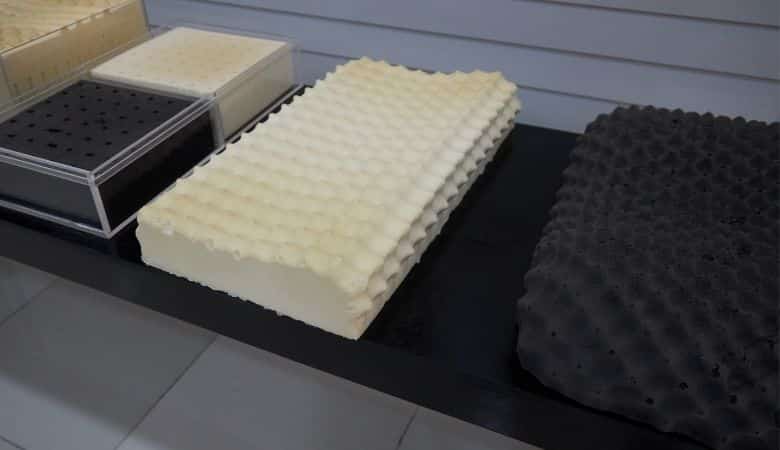
Latex pillows can either be made from natural/organic or synthetic material. Natural latex is tapped from the rubber tree ( Hevea Brasiliensis), while synthetic latex is made from petroleum products.
The most common compounds used in making synthetic rubber are Styrene and Butadiene. Synthetic latex is sometimes referred to as SBR (Styrene-Butadiene Rubber). The pillows are made from the latex using either the Dunlop method or the Talalay process.
What’s the Difference Between Natural Latex and Synthetic Latex?
Natural latex is odor-free, eco-friendly, and more durable than synthetic latex. It is also softer and ideal for people prone to allergies as it is chemical-free. The downside is that it is more expensive than synthetic latex, denser and heavier and also not as available as synthetic latex.
Synthetic rubber has unpleasant chemical odors which could trigger allergies in some people. It also has a larger carbon footprint and is thus less eco-friendly. However, it is cheaper and more available as compared to natural latex. It has a shorter lifespan as compared to natural latex. Another disadvantage is that it is easier to break down and flatten.
What’s the Difference Between the Dunlop Process and Talalay Process?
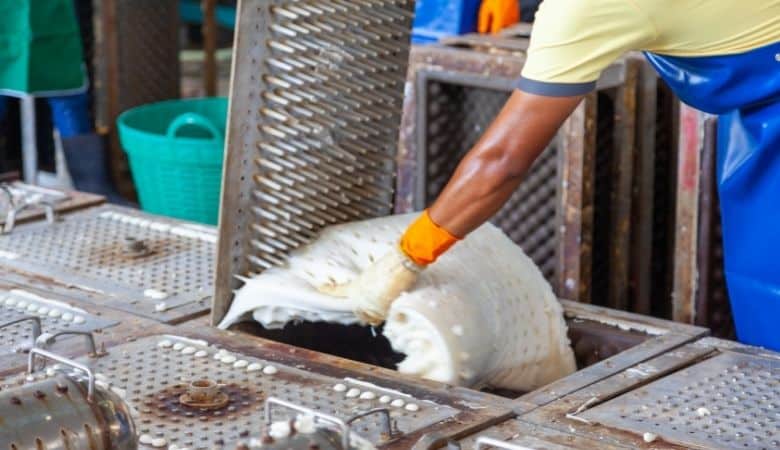
The Dunlop and Talalay processes are the main methods used to manufacture latex pillows.
Dunlop process
This is the traditional method of manufacturing latex. Thick rubber sap is whipped into a froth using a centrifuge and poured into a mold. After capping, the mold is moved to a vulcanization oven where vulcanization (hardening) occurs. After vulcanization, the latex is removed from the mold and washed clean off any soaps and other materials.
It is then dried at high temperatures to remove moisture. It produces dense, bottom-heavy pillows that may not be cushy but provide excellent support for the neck and back and are ideal for relieving sleep-related pain. Pillows manufactured using this process are akin to memory foam in terms of consistency.
Talalay process
This is a more modern latex manufacture method. It is currently the preferred method as it allows manufacturers to tweak the process and create specific levels of comfort and support. Natural or synthetic rubber, soaps, and rubber curing agents are mixed in a stainless steel vacuum container until they create a latex foam.
The foam is then molded and frozen to give it shape and strength. Carbon dioxide gas is then introduced to the foam to create a gel. Then, finally, the mixture is vulcanized at a temperature of 220 F to harden and improve stability. This process is more convoluted and energy-intensive, unlike the simple Dunlop process, but it creates a different type of latex.
Talalay process creates latex that is bouncy, springy, and has a weightless feel. In addition, due to the freezing stage in the process, particles do not congregate at the bottom of the mold, as is the case in the Dunlop process. Thus, the Talalay process creates a more uniform and consistent product.
It also creates a more breathable product with an open cell structure that ensures adequate ventilation and excellent airflow. This is in sharp contrast to products made with the Dunlop process, which has a small cell structure that causes it to trap heat and hence reducing its breathability.
Advantages of Latex Pillows
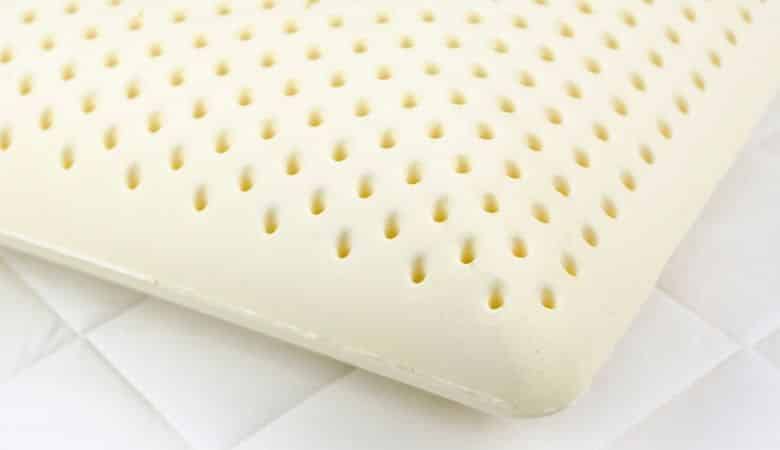
1. Provides adequate support
A pillow is vital as it supports close to a fifth of your overall sleeping surface. A latex pillow molds itself around your natural sleeping form providing essential support to the head, neck, and shoulders, ensuring you have a restful sleep. Latex pillows are denser than memory foam, fiber, or even down pillows and can withstand more punishment than other types of pillows.
They are impression-resistant and will hold their shape for years as other pillows slowly conform to repeated use. In addition, they remain soft and pliable, providing the right level of support over the years.
Some latex pillows are fashioned from individual pieces of soft foam that you can add to or remove to get the precise level of comfort and support you yearn for.
2. Less noise
Latex pillows have almost zero noise in regards to squeaking or rustling. So you will not get any distractions as you are trying to drift off to sleep.
They also provide such superior levels of support that they can keep your airways clear, reducing the chances of snoring or other noises associated with breathing.
3. Durability
If you are searching for durability in your pillows, look no further than latex pillows. They are by far the most durable pillows available in the market, as they retain their shape and springiness for a long time.
Coupled with the fact that they are hypoallergenic (insusceptible to dust, bacteria, or mold), you can use them for a long time, where other types of pillows will have become health hazards after similar periods of use.
In addition, latex pillows, particularly those from natural rubber, will continue providing much-needed head, neck, and shoulder support for years without losing shape, making them a worthwhile investment.
4. Maintains ideal temperature
As you sleep in your bed, temperatures increase, which can be uncomfortable or lead to copious sweating; this problem can be minimized or alleviated by using latex pillows. Latex pillows (Talalay type) have an open cell structure that promotes ventilation and increases breathability.
As a result, they remain cool all night regardless of prevailing room temperature or if you are naturally a hot sleeper. Thus, latex pillows help you to retain comfortable, consistent, and convenient sleeping temperatures all night long.
5. Hypoallergenic
Latex pillows are recommended if you have sensitive skin or are prone to allergies. Natural latex is best for such cases as it is odor-free and it does not harbor any dust, microbes, dust mites, or any other ungainly bedroom critters. Ensure the pillow is covered with a cotton pillowcase that can be easily washed or replaced if dirty.
Most pillows are usually replaced within two years after they are found to harbor bacteria, mold, mildew, and dust mites, but latex pillows can go as far as five years if properly cared for.
Latex pillows are recommended for those with respiratory issues due to their hypoallergenic features. Natural organic latex is recommended for sensitive skin, although those with latex allergies should not use it.
6. Recommended to alleviate pain and pressures as you sleep
If you suffer from pains and pressures every time you wake up due to sleeping posture and position, latex pillows could be just what the doctor ordered.
Latex pillows provide unparalleled soft support to your head, neck, shoulders, and back, reducing any pains and pressures upon waking up.
No other pillow fill on the market can provide such superior support and comfort, ensuring proper spinal alignment and restful sleep.
7. Environmentally conscious and eco-friendly product
This tag applies to pillows made from natural latex since their raw material is sap from the rubber tree. The manufacturing process of these latex pillows has a smaller carbon footprint, and these pillows have more longevity than other types of pillows.
Disadvantages of Latex pillows
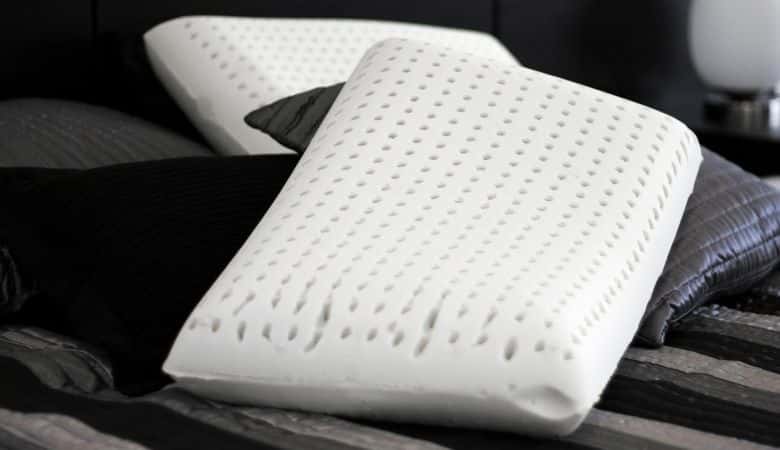
1. Expensive
Latex pillows are pricier than other pillows, with the Dunlop type averaging $50 while the Talalay type costs an average of $70. However, this cost is offset by the myriad benefits and perks of owning one.
2. Less availability and variety
Their availability is limited compared to other types of pillows like polyester, memory foam, down, and other fillings. They are also made from mold, so variety is limited, and you can only choose from granule, contour, and wave pillows.
3. Heavy
Latex pillows are usually heavier and denser than other pillows, which could be an issue to move and adjust in the dead of night half-asleep. However, most users do not consider this a substantial issue.
4. Smell
Synthetic latex pillows have an unpleasant odor while new though this odor dissipates with continued use. If you want to avoid this fault, opt for natural organic latex, which is odor-free
5. Allergy to latex
Latex pillows are harmful to people who are allergic to latex material. They should opt for other types of pillows to stay out of harm’s way.
6. Difficult to clean and dry
Latex pillows are not machine washable and should not be dried in direct sunlight. A good pillowcase cannot be over-emphasized to keep the pillow clean.
What to Look for When Shopping for a Latex Pillow
Once you have decided to go for a latex pillow, you need to weigh come factors to help you refine your search for the ideal latex pillow
Thickness/loft
It is good to have the loft of your pillow in mind as you prepare to buy. Pillows with high loft are advisable for those who sleep on their sides or back as it puts the body in a more natural position. Low loft pillows are recommended for those who sleep on their stomachs to prevent unnatural sleeping positions.
Firmness
Do you prefer a firm or soft pillow? This measure is determined by latex density. Be sure to check the comfort of your pillow before taking it home.
Friendliness to skin
If your skin is very sensitive or prone to allergies, latex pillows are your panacea. They are naturally hypoallergenic and are not prone to the buildup of dirt, mold, mildew, bacteria, and other undesirable flora and fauna. Avoid latex pillows if you have an allergy or adverse reaction to latex; otherwise, a latex pillow can be used by everyone else.
How to Clean Your Latex Pillow
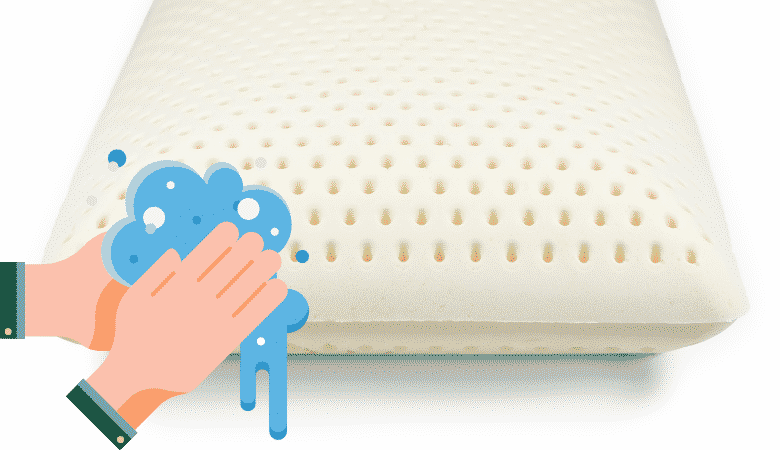
Since you should not machine wash your latex pillow, spot-cleaning is recommended.
- Dust off the pillow first by taking it outside and hitting it with the open palm a few times. You can also use a vacuum machine on a low suction setting. Make sure to remove all the dust and loose debris from the pillow.
- If you get any spillage on your pillow, blot out the stain and spot clean it to prevent permanent stains. Use a folded white cloth or pieces of paper towels over the affected area until no more liquid comes from the pillow. Avoid colored pieces of clothing as they might bleed into the pillow.
- Mix warm water, mild detergent, and baking soda in a bowl until you get a syrupy consistency, dip a white cloth in the mixture and blot the spot you wish to clean.
- Leave it on for fifteen minutes, and then wipe the treated spots with a damp cloth until you can no longer see any remaining residues on the pillow.
- Air-dry the pillow away from direct sunlight.
- If the stain is large, work from the outside inwards to prevent spreading the stain.
However, you can only spot wash so often; eventually, you will need to wash the pillow.
- Do not machine wash your pillow, as it will destroy the delicate latex structure.
- Fill the tub half-full with very hot water. You might need gloves if you can’t stand the heat. This hot water eliminates dirt, mold, and bacteria.
- Pour about I tablespoon or 15 ml of mild detergent in the tub and agitate to form suds.
- Soak the pillow, squeeze and massage the fillings of the pillow, continue until you remove all dirt and the soapy water reaches the pillow’s central core.
- Rinse until all the soapy water is removed from the pillow. It may take a few rinses with fresh water.
- Squeeze out excess water with your hands. You can also lay the pillow down on a dry towel and press it down. Avoid twisting movements as they might destroy latex structure.
- Air dry in dry and sunny weather away from direct sunlight. You can hang or lay on a flat surface. Be sure to shake and massage the fillings as they dry to make sure they remain comfortable after they dry.
If you want to learn more about cleaning your latex pillow, check out this post.
Summary
Latex pillows are recommended for deep, restful sleep, and their longevity is unmatched. However, ensure you get an excellent pillowcase to keep the pillow clean as it is a hassle to clean. However, you should avoid them at all costs if you have a latex allergy.
Latex Pillows: A complete buyers guide – Parts:
1. Why Should You Use A Latex Pillow? The Pros and Cons
2. Latex vs Memory Foam Pillows: What’s the difference and which is better?
3. Are Latex Pillows Safe? What about the smell?
4. How Long Do Latex Pillows Last? This is the replacement time
5. How to Wash And Dry a Latex Pillow: Step by step guide
6. Best Latex Pillows of 2021 – Full Guide and Review
